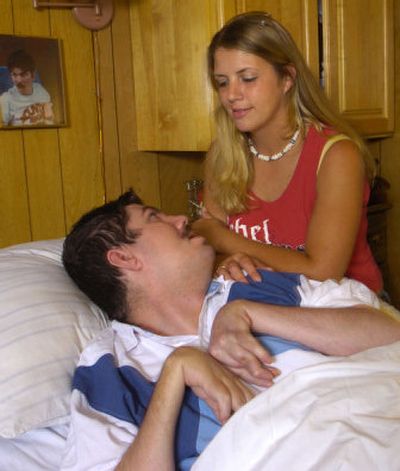Doctors find proof man’s brain fixed itself

Doctors have their first proof that a man who was barely conscious for nearly 20 years regained speech and movement because his brain spontaneously rewired itself by growing new nerve connections to replace the ones severed in a car crash.
Terry Wallis, 42, is one of the few people known to have recovered so dramatically so long after a serious brain injury. He still needs help eating and cannot walk, but his speech continues to improve and he can count to 25 without interruption.
The research on Wallis, published Monday in the Journal of Clinical Investigation, was led by imaging expert Henning Voss and neurologist Dr. Nicholas Schiff at the Weill Medical College of Cornell University in New York City and included doctors at JFK Medical Center in Edison, N.J.
Wallis’ sudden recovery happened three years ago at a rehabilitation center in Mountain View, Ark., but doctors said the same cannot be hoped for people in a persistent vegetative state, such as Terri Schiavo, the Florida woman who died last year after a fierce right-to-die court battle. Nor do they know how to make others with less serious damage, like Wallis, recover.
“Right now these cases are like winning the lottery,” said Dr. Ross Zafonte, rehabilitation chief at the University of Pittsburgh Medical Center, who was not involved in the research. “I wouldn’t want to overenthuse family members or folks who think now we have a cure for this.”
Wallis has complete amnesia about the two decades he spent barely conscious, but remembers his life before the injury.
“He still thinks Ronald Reagan is president,” his father, Jerry, said in a statement, adding that until recently his son insisted he was 20 years old.
Wallis was 19 when he suffered a traumatic brain injury that left him briefly in a coma and then in a minimally conscious state, in which he was awake but uncommunicative other than occasional nods and grunts, for more than 19 years.
“The nerve fibers from the cells were severed, but the cells themselves remained intact,” unlike Schiavo, whose brain cells had died, said Dr. James Bernat, a neurologist at Dartmouth-Hitchcock Medical Center in New Hampshire.
Nerve cells that have not died can form new connections.For example, nerves in the arms and legs can grow about an inch a month after they are severed or damaged. However, this happens far less often in the brain.
The new research suggests that instead of the sudden recovery Wallis seemed to make when he began speaking and moving three years ago, he actually may have been slowly recovering all along as nerves in his brain formed new connections at a glacial pace until enough were present to make a network.
Researchers used a new type of brain imaging only available in research settings – not in ordinary hospitals or rehabilitation centers – to establish the regrowth. It tracks the direction of water molecules in and around brain cells, an indicator of brain activity.
Doctors compared Wallis’ brain function to that of 20 healthy people and another minimally conscious patient who showed virtually no recovery for six years. All were imaged twice, 18 months apart.
The second set of images showed changes from the first, strongly suggesting that new connections had formed. These correlated with areas of the brain that affect the ability to move and talk.
“We’ll have to understand more about why recovery occurred” in Wallis’ case, Zafonte said. “The question is ‘why?’ It’s not just ‘wait.’ “
Until that is known, imaging cannot be used to predict who will recover, or to help patients’ brains rewire, he said.